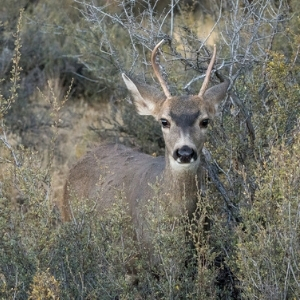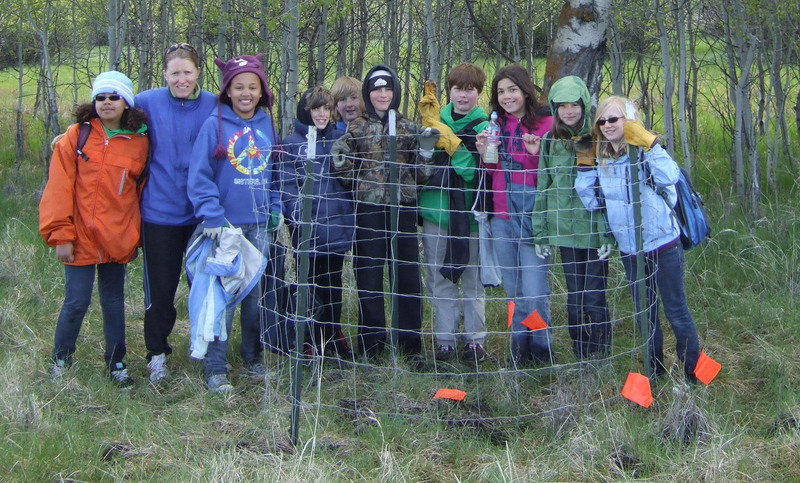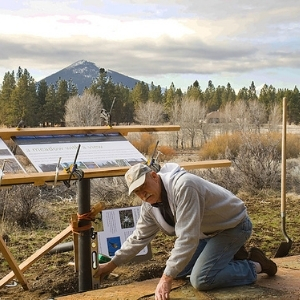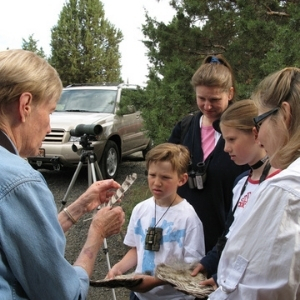In honor of the Land Trust’s 25th Anniversary, we’re sharing the stories of our flagship Preserves—the places, the people who have helped care for them, and the power they have to create a brighter future.
You can stand there with the sun warming your face, the wind gently bending the grasses, the snow-capped mountains looking down at you and you feel connected. This humble little meadow near Sisters, Oregon has inspired so many over the years including a group of local community members who would go on to start the Deschutes Land Trust. 
The meadow also had a long history for local communities. Since time immemorial, this wet meadow served as a traditional camp site and seasonal hunting and gathering grounds for the region’s indigenous people. As explorers, surveyors, soldiers and eventually white settlers arrived, the native people were displaced, the vegetation grazed by livestock, the creek controlled and the meadow transformed.
Livestock grazing would dominate Indian Ford Meadow from ~1870-1990, with hobby ranching and recreational home development eventually displacing ranching by the mid 1990’s. The meadow was part of the historic Willows Ranch, but as time passed, shifting attitudes and changing demographics would come to value scenic views and wildlife over cattle and sheep production. By 1995, the owners of the Willows Ranch had become intrigued with the concept of land trusts and the tax advantages of potentially donating an unneeded, but scenic pasture. At the same time, a nascent group of public employees in Bend was exploring the creation of a regional land trust, which would become the Deschutes Basin Land Trust in 1995. In May 1996, the owners of the Willows Ranch worked with the Oregon Community Foundation to facilitate a donation of Indian Ford Meadow to the Land Trust forever protecting the meadow.
With Indian Ford Meadow Preserve officially established, volunteers at the Land Trust rolled up their sleeves and got to work! Non-native weed removal was a top priority in the early years and volunteers spent countless hours pulling mullein, thistle, and other weeds. One of our first dedicated weed groups was born at Indian Ford Meadow Preserve: the Phalaris Fairies! This group of volunteers including Judy Clinton, Bonnie Lamb, Karen Allen, Darcy McNamara, and Maret Pajutee worked hard to eliminated Phlaris arundinacea, or reed canary grass, in and along Indian Ford Creek.
Early restoration projects included helping make one of the most iconic features of the Preserve healthier. Aspen are more than the average tree, providing year-round benefits to wildlife and people. From spring nesting and foraging opportunities to summer shade and fall foliage—the Land Trust was committed to helping them thrive. Our aspen restoration efforts included thinning juniper and pine trees that had grown in over the years, creating snags (dead standing trees) for nesting birds, and working with students at the University of Oregon and Cascades Academy to cage young aspen saplings from browsing deer and elk. Today the enclosed aspen are thriving and are now tall enough that deer and elk browse can no longer cause significant damage. This fall we are planning to remove the cages and move them to other aspen that can use the protection. We will also be working with the University of Oregon once again on a study to determine the best areas within aspen groves to exclude browsing animals and get the best results using the least amount of fencing. 

As the Land Trust celebrates its 25th anniversary, Indian Ford Meadow Preserve is a beacon of light and hope for the future. It is a testament to what we can accomplish together as a community. You can still stand there with the sun warming your face, the wind gently bending the grasses, the snow-capped mountains looking down at you and you can still feel connected. With you by our side, we can protect special places for future generations. We can return health to the natural world. We can learn from the land and the people who care for it. What does the next 25 years hold for the Indian Ford Meadow Preserve? Undoubtedly adapting and changing as the natural world, our climate, and our community grow and change. Your Land Trust will be here as a guide along the way. We hope you’ll join us!
Learn More:


The Story of Indian Ford Meadow Preserve
Deer stands at Indian Ford Meadow. Photo: Tim Cotter.
Students from Cascades Academy smile for a photo while working to cage aspen. Photo: Land Trust.
Dick Tipton installing interpretive sign. Photo: Land Trust.
Norma Funai talks to group about feathers. Photo: Land Trust.
